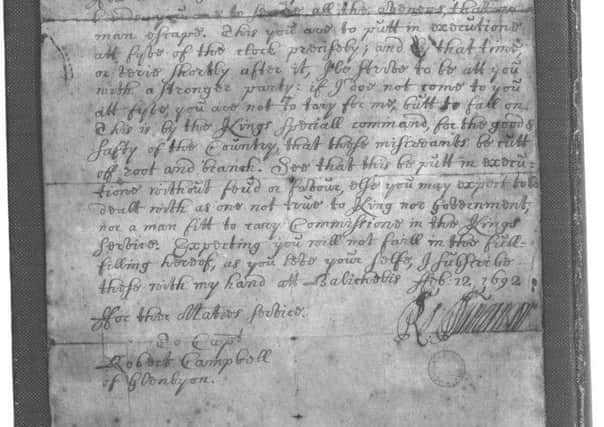Massacre of Glencoe remembered in National Library


Now the paper carrying the order for the Glencoe Massacre has become the centrepiece in an exhibition charting decades of turmoil, conflict and political intrigue in Scotland.
The handwritten document, which led to the slaughter of 38 members of the MacDonald clan, is at the heart of a new National Library of Scotland show next year marking the 300th anniversary of the 1715 Jacobite Rising.
Advertisement
Hide AdIt explores the complex web of royal dynasties, family infighting and political maneuvering that was to change the face of Scotland forever, including the key events that led to the Act of Union of 1707.
Some of the items in the exhibition, Game of Crowns, are rarely seen, and have been loaned by the Queen’s own Royal Collection at Windsor Castle, as well as the National Records of Scotland in Edinburgh, and two of the city’s other attractions, the National Museum of Scotland and the Scottish National Portrait Gallery.
The exhibition traces the events that led to the Glencoe massacre back to the removal of King James VII & II from the throne of both Scotland and England because he was Catholic. Those Scots who continued to support James – Jacobus in Latin – after he was exiled to France were known as “Jacobites” and the massacre at Glencoe was ordered to dispose of Highland clan members who were thought to have refused to swear allegiance to the new king, William of Orange.
CONNECT WITH THE SCOTSMAN
• Subscribe to our daily newsletter (requires registration) and get the latest news, sport and business headlines delivered to your inbox every morning
The 1715 uprising, which ended in failure for the Jacobites, was to be led by “The Old Pretender” James Francis Edward Stuart, son of James VII, who lost the chance to rule because of his Catholicism and ended up living in exile in Rome.
Referring to the Glencoe Massacre document, exhibition curator Robert Betteridge said: “You can’t get much closer to history than this. Visitors to the exhibition will be able to see a document that was written over 300 years ago and then passed on to the people who were to carry out the massacre. It was a deed so shocking in its execution that it has remained strong in the memory of generations of Scots.”
Advertisement
Hide AdBrought together for the exhibition are letters, manuscripts, books, maps, portraits and even a Jacobite sword. Although the exhibition touches on the later Jacobite rebellion Bonnie Prince Charlie, the Old Pretender’s son, led in 1745, it largely focuses on the earlier rising and its less-romantic cast of characters.
Mr Betteridge added: “The 1715 Jacobite Rising, and circumstances around it, are certainly less well-known than the 1745. That’s partly down to Bonnie Prince Charlie, who has hijacked a lot of the Jacobite myth, but the 1715 Rising was much better supported by the people of Scotland.”
Advertisement
Hide AdGame of Crowns is at the National Library of Scotland until 10 May next year.
How Highland hospitality was followed by betrayal
THE Glencoe Massacre followed a proclamation issued in August 1691, which required all the chiefs of the Scottish clans to take an oath of allegiance to the new king, William of Orange, before the end of the year.
He had been determined to bring the often unruly Highland clans into line and offered a pardon in an attempt todo so.
But many clan chiefs were waiting until word had come from the exiled King James before they took the oath.
John Dalrymple, secretary of state for Scotland, the king’s representative north of the Border, was looking for an excuse to make an example of one of the clans.
Alasdair MacDonald (or MacIain), the clan’s chief, arrived at Fort William on 31 December, 1691 to take the oath but was told that he would have to travel some 70 miles to see a sheriff at Inveraray, in Argyll.
Advertisement
Hide AdMacIain finally took the oath on 6 January, 1692 and was given assurances that his people were safe. Under a plot hatched by Dalrymple, about 120 troops arrived at Glencoe on 2 February under the command of Captain Robert Campbell of Glen Lyon. They were given hospitality by the MacDonalds, as was customary in the Highlands.
Then Captain Campbell received orders from his superior, Major Duncanson, instructing him to “fall upon the rebels, the MacDonalds of Glencoe, and put all to the sword under seventy.”
SCOTSMAN TABLET AND IPHONE APPS